The URL for this blog has changed to
https://www.tekla-szymanski.com/blog!
Please visit me there. Thank you.

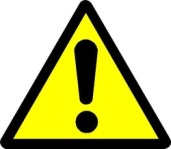

 The Leo Back Institute in New York is showing a new exhibit about Jewish Life in Munich, 1806-present, until July 31, 2013. “Beer Art and Revolution” sheds a light on Jewish life in Bavaria’s capital.
The Leo Back Institute in New York is showing a new exhibit about Jewish Life in Munich, 1806-present, until July 31, 2013. “Beer Art and Revolution” sheds a light on Jewish life in Bavaria’s capital.
“Before the Nazi regime, Jews were instrumental in shaping the traditions and character of Germany’s third largest city, from Löwenbräu beer to the top purveyor of Lederhosen and Dirndl to the city’s champion soccer club. Like Jews across Germany, they considered themselves as much Germans as Jews, but they could add a third identity to their hyphenated existence – Bavarian. Today, seventy years after the end of World War II, Munich is again home to a flourishing community of 11,000 members, the second largest in Germany.”

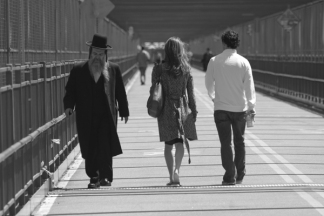
The German Consulate General is showing until July 18 a photo exhibit by Julian Voloj — Only in New York, depicting New York’s vibrant Jewish community.
“Since moving to New York in 2003, the exploration of Jewish identity has become a leitmotif in the work of photographer Julian Voloj. Growing up in Muenster, Germany, in a small Jewish community, he became interested in Jewish diaspora culture around the world.
Fascinated by the vibrancy and diversity of New York’s Jewish communities, he started to explore what it means to be Jewish. His photographs are an intimate portrait of a variety of Jewish communities, former Jewish neighborhoods, and expressions of identity.
From Hasidic Jews in Brooklyn and their struggle between tradition and modernity, to African-Americans who adopted Jewish rituals to cope with the legacy of slavery, his photographs open the doors to unknown worlds.
Julian Voloj’s award-winning photography has appeared in various newspapers and magazines including the Washington Post, Forward, Tablet Magazine, Publishers Weekly, and the Jerusalem Post. Voloj is also the founder of JWalks: Retracing Jewish Heritage, a nonprofit promoting Jewish history through walking tours. Julian Voloj lives with his wife and two children in New York City.”
If you are interested in learning more about Jewish New York, visit J-Walks: Retracing Jewish History in New York City.

 Visit the Center for Jewish History for this special exhibit about Jews in New York, March 15-August 2012:
Visit the Center for Jewish History for this special exhibit about Jews in New York, March 15-August 2012:
“Over their centuries-long relationship with New York City, Jews have carved out a multitude of public and private spaces as their own, including neighborhood streets, businesses, synagogues and tenement apartments, as well as the temporarily-Jewish stadiums, squares and concert halls that served as venues for special events. Discover the various identities of New York Jews (from the years 1700 – 2012) by exploring the spaces that they have created for themselves. Learn how Jews have shaped New York, how the largest city in the U.S. has molded the Jews and what Jewish spaces in the city reveal about the many varieties of “New York Jews” who have lived here.”

 The United States Holocaust Memorial Museum has launched a new project “Remember Me: Displaced Children of the Holocaust.”
The United States Holocaust Memorial Museum has launched a new project “Remember Me: Displaced Children of the Holocaust.”
The Museum is asking for your help to identify displaced children and document what became of these young Holocaust survivors after the war.
“They are the most vulnerable victims of war and genocide. Between 1933 and 1945, millions of children were displaced as a result of persecution by the Nazis and their collaborators. After World War II, relief agencies photographed some of the children who survived to help find their families. Now, more than 65 years later, the United States Holocaust Memorial Museum is working to discover what became of these young survivors.”
On the museum’s website, you can browse the names of the children or view their pictures. Please contact the museum at RememberMe@ushmm.org or click on “I remember this child!” button near his/her individual photo if you recognize a child or see yourself in the pictures. The images for this project have been provided by the United States Holocaust Memorial Museum, The Jacob Rader Marcus Center of the American Jewish Archives and The Museum of Jewish Heritage, A Living Memorial to the Holocaust.
The photo above shows Berthe Moscowicz, who now goes by the name Bracha Aris and lives in Israel. She came across her own picture in the photo gallery and identified herself.

 A new Jewish newspaper, the Jewish Voice From Germany, will be launched in Germany beginning next year. The English-language quarterly will be published in Berlin starting in January 2012 by novelist and political commentator Rafael Seligmann with an initial circulation of 25,000.
A new Jewish newspaper, the Jewish Voice From Germany, will be launched in Germany beginning next year. The English-language quarterly will be published in Berlin starting in January 2012 by novelist and political commentator Rafael Seligmann with an initial circulation of 25,000.
In his welcoming message, Seligmann writes: “There is a revival of Jewish life in Germany. But […] little is known about the fertile German-Jewish relations.”
“Germany is politically and economically one of Israel’s most reliable and important partners. A communication-bridge is missing between German-speaking countries and the influential Jewish communities in the U.S., Canada, GB and Israel. Jewish Voice From Germany will forge this missing link. [It] supplies information and provides commentaries for disseminators in economics, politics, sciences and arts. Our paper will help revive German-Jewish relations and voice mutual interests.”
If you wish to subscribe to the publication, please send your address to: info@jewish-voice-from-germany.de.

Here is a query from a reader. Please reply to her directly or comment to this post.
My name is Charla R. Malamed. I am a doctoral student at Derner Institute, at Adelphi University on Long Island, New York.
I am currently conducting a research project, in which I am interested in learning about the transmission of Holocaust WWII experience across the generations, and about how that experience influences the individual’s relationships with the self and with others, specifically with a German/Jewish individual (German non-Jewish, if the individual is Jewish; Jewish, if the individual is German non-Jewish).
I want to understand how cultural and familial memory of the Holocaust influences the development of the self and the ways in which an individual is able to relate to the ‘other;’ that is, how has the Holocaust affected Jewish/German non-Jewish relations today, in the 3rd generation?
To be eligible to participate, you must:
(1) Be a grandchild of a someone who lived during the Nazi regime in one of the Nazi-occupied territories
(2) have had, or currently have, a meaningful and ongoing relationship with a German non-Jewish individual (if you are Jewish) or a Jewish individual (if you are German and non-Jewish).
Anyone who is interested will be asked to participate in a 75-90 minute interview, as well as complete a pencil-and-paper questionnaire. All the information resulting from this research will be anonymous.

 This post will no longer be updated and has moved to my website, where it will be updated as needed: https://www.tekla-szymanski.com/searching-for-german-jews-in-new-york/
This post will no longer be updated and has moved to my website, where it will be updated as needed: https://www.tekla-szymanski.com/searching-for-german-jews-in-new-york/
In early May, the Leo-Baeck Institute in New York and the Baruch College Jewish Studies Center held a conference entitled “German-Speaking Jews in New York City: Their Immigration and Lasting Presence”.
Only a handful of German-Jewish émigrés, who had fled to the United States from Germany in the early 1930s, were present. I was sitting in the audience, missing the many German-Jews whom I’ve met in New York in the early 1990s, when I was managing editor of the legendary German-Jewish newspaper Aufbau (which was founded in 1934 and folded in 2004. Read my article about Aufbau’s history, in German). I remembered our devoted German-Jewish readers, so attached to their paper that they would call the office to ask for the time. I missed our German-Jewish freelance writers and photographers, who had so much inner strength, poise and intellect.
The almost empty auditorium at the Leo-Baeck Institute made me miss them even more.
It was ironic that of all the Jewish institutions in New York, it was the Leo-Baeck Institute that hosted a conference like this. Even though the Institute has dedicated itself to preserving German-Jewish culture, back when Aufbau struggled to survive, we approached its directors again and again to help us save the paper, at least as long as there was still one survivor, one German-Jew, alive. Our pleas, however, fell on deaf ears. To be fair, there were a few individuals on the Institute’s board who supported us as much as they could, but officially, the Leo-Baeck Institute never seemed to care too much about Aufbau’s demise.
Now, panelist after panelist remembered the Aufbau and its important role in the survivors’ lives. For them, however, and for the paper, these reminiscences and acknowledgements come too late.
I miss the resolute Werner Stein and the soft-spoken Jerry Brunell, chairman and publisher respectively of the Aufbau. I had fierce discussions with both of them about which direction the paper should take, but I always learned something new from their experiences; their stories will stay with me forever. (Werner Stern contacted me on June 16, after learning about this blog post, and I was glad to learn that he is well! I hope that Jerry Brunell is too.)
I miss our freelance writers, like our 80-year-old art critic Judith Helfer, who had the wrinkle-free face of a delicate Chinese porcelain doll and a soft voice to match her features. Judith came from a prominent family of Rabbis; she died in 2002.
I miss Frederick R. Lachman (top right), a Jewish scholar, author, historian and executive editor of the Encyclopedia Judaica, who wrote Aufbau‘s column “Was das Judentum dazu sagt”, on how Judaism approached the issues of the day. Lachman — with his disarming wit, poignancy and very long-form writing style — once took me aside and shared with me his anguish that some people still thought that German-Jewry started with Hitler. “Child,” he urged me, “continue to fight this misjudgment.” I have and always will. Lachman died in 1998 at the age of 96.
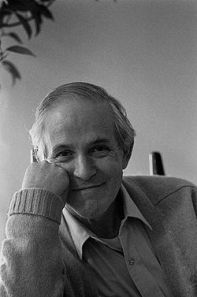 I miss our photographer Erich Hartmann (at left), who worked for MAGNUM and accompanied me to many assignments, most memorably to an interview with Wolf Ulrich von Hassell, the son of a German resistance fighter in Nazi Germany. You can read the article (in German) and view the photo Hartmann took here. Hartmann, who was as elegant and polite as an English gentleman and such a Mensch, passed away in 1999.
I miss our photographer Erich Hartmann (at left), who worked for MAGNUM and accompanied me to many assignments, most memorably to an interview with Wolf Ulrich von Hassell, the son of a German resistance fighter in Nazi Germany. You can read the article (in German) and view the photo Hartmann took here. Hartmann, who was as elegant and polite as an English gentleman and such a Mensch, passed away in 1999.
I miss Lisa Schwartz (bottom, at right), who was the vice president and Grande Dame of Aufbau. As a former hat model, she was as eccentric and charming as you’d imagine, and I miss her dry humor and hearty laughter. She chain-smoked and flirted with everyone. She had survived the war in Switzerland as a child and still vacationed there every year. We lost contact; but I do hope she is alright. [Update: Lisa Schwartz passed away in March 2012 at the age of 90. May she rest in peace.]
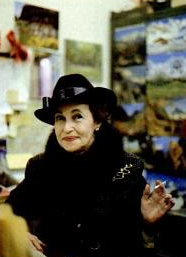 Years back, all of them would have been present at a conference like that, either participating in the panels, sitting on the podium, or in the audience.
Years back, all of them would have been present at a conference like that, either participating in the panels, sitting on the podium, or in the audience.
But very few people sat there with me now, as if I needed a reminder that their numbers were dwindling and that their children and grandchildren, for the most part, didn’t care much about their German-Jewish roots.
But there are still a few witnesses, like retired history professor Henry L. Feingold and Max Lerner, who came to New York from Germany and Austria respectively in the late 1930s early 1940s. Both recounted their experiences after arriving in the New World:

Representing the second and third generation was author and poet Janet R. Kirchheimer (How to Spot One of Us), who shared her grandparents’ and parents’ experience after coming to New York.
In her poems (i.e. “This Is How My Opa Strauss Died“), she comes to terms with her own German-Jewish heritage and identity:
I don’t know how many survivors will sit in the audience, or on the podium, next year. But I do know that I will miss those who won’t.

Here is a query that I received from two readers. Please respond directly to them:
Hello,
We are beginning a project that we believe might be interesting to you. Our intent is to bring together 3rd generation (grandchildren) of victims and perpetrators of the WW2 Holocaust such as Jews, homosexuals, sympathizers, Nazi, SS, Polish, Vichy, etc. We wish to create a safe, open space to inclusively listen and experience each other’s stories of growing up and living with family members who lived during the Nazi period. This space will be open in many ways and might include modes of expression that go beyond words, like movement, free association, and expressive theater.
We will use questions about our formative experiences with family, in school, and with friends to structure the circle.
Questions might look like the following:
- When did you first learn about the Holocaust?
- What ideas do I have about my own community and about the ‘others’ community?
- What do we know about our own historical links to the Holocaust?
- What was it like to be a grand-daughter of a Nazi soldier or a survivor?
- What is guilt, what is forgiveness, what is reconciliation?
- What do you feel when you meet a German/Jew?
- What is the role of commemoration?
We ask that all participants hold the intention to go beyond blame. We hope that in experiencing the stories of each other, we will begin to build a shared experience, one which struggles to move beyond the conventional notions of the ‘other’ with which most of us have been raised. Meetings will be facilitated and will follow guidelines to maintain structure, confidentiality and the emotional safety and stability of the circle. The purpose of the group is not to debate or argue historical facts, but rather to encounter each other and listen deeply to each other’s stories and truths. Participants must be committed to a self-transformative process.
At this stage, we call for all those interested to write in with a short statement including an introduction, your relation to the Holocaust, and your intent for joining. Once we gather a solid group we will announce our first meeting. If you know of others that are linked historically to the Holocaust and might be interest, please send this invitation along.”
Rami Efal and Charla Malamed, Charlarubym@gmail.com

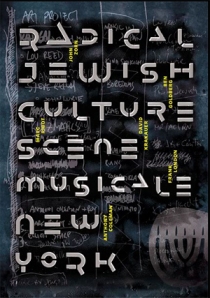 The Jewish Museum in Berlin is showing a new exhibit on the contemporary Jewish music scene in New York, from April 8 to July 24, 2011.
The Jewish Museum in Berlin is showing a new exhibit on the contemporary Jewish music scene in New York, from April 8 to July 24, 2011.
From the curators: “Radical Jewish Culture is an avant-garde Jewish music movement that developed in the New York underground scene at the beginning of the 1990s. Musicians such as John Zorn, David Krakauer, Marc Ribot, Anthony Coleman, and Frank London passionately explored the possibilities for a new form of Jewish music, emancipating themselves from conformity and inconspicuousness. Their music blended free jazz forms with klezmer improvisations, experimental music with rock, blues, and punk. The exhibition »Radical Jewish Culture« presents this music scene through audiovisual documents, lots of music samples, and primarily unpublished material.”

 Kurt Münzers 1928 erschienene Buch Jude am Kreuz ist jetzt erstmalig wiederveröffentlicht worden: Unter ISBN Nummer 978-3-923211-85-2 beim Verlag Autonomie und Chaos, Leipzig-Berlin.
Kurt Münzers 1928 erschienene Buch Jude am Kreuz ist jetzt erstmalig wiederveröffentlicht worden: Unter ISBN Nummer 978-3-923211-85-2 beim Verlag Autonomie und Chaos, Leipzig-Berlin.
Münzer (1879-1944) war ein deutsch-jüdischer expressionistischer Schriftsteller, dessen Werke sich mit dem sozialen und seelischen Leben in Deutschland zwischen 1910 und 1933 sowie der deutsch-jüdischen Identität befassten und in hoher Auflage erschienen.
Der Roman Jude am Kreuz “enthält eine tiefgründige poetisch-literarische Auseinandersetzung mit dem Sinn des Jüdisch sein angesichts der zunehmenden antisemitischen Pogromstimmung im Deutschland der 20er Jahre.”
Das Buch kann als PDF kostenlos heruntergeladen werden.

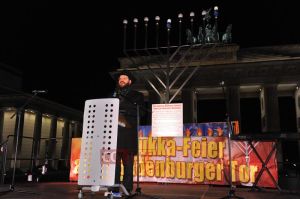 The leaders of Berlin’s Jewish community set up a 20-foot (six-meter) tall Chanukiah on Wednesday against the backdrop of one of Germany’s most historically important symbols, the Brandenburg Gate.
The leaders of Berlin’s Jewish community set up a 20-foot (six-meter) tall Chanukiah on Wednesday against the backdrop of one of Germany’s most historically important symbols, the Brandenburg Gate.
The newly elected president of Germany’s Council of Jews, Dieter Graumann, told the daily Tageszeitung that Germany’s aging Jewish community needs to attract younger people and ensure that the Holocaust “should not be the only cement holding Jews together.” The menorah is stationed next to a 56-foot (17-meter) high decorated Christmas tree erected last week.
The Jewish Telegraph Agency writes:
“It marks the sixth year that Chabad of Berlin, with the support of numerous Jewish organizations, has hosted a Chanukah first-night celebration at the Brandenburg Gate. In 2004, [Chabad’s Rabbi in Germany, Yehudah] Teichtal won permission from the German government, arguing that this would be an event of national importance worthy of such a location.
Sure enough, the image of rabbis dancing in front of the Chanukah menorah at the Brandenburg Gate appears in newspapers and on websites around the world. The message is clear: In Germany, the Jews live again.”


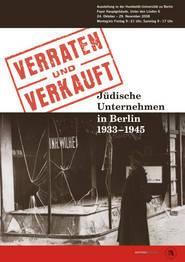 The Leo Baeck Institute in New York will be showing a new exhibit, “Final Sale: The End of Jewish Owned Businesses in Nazi Berlin.” The exhibit opens December 9 and will run through March 31, 2011 at the Katherine and Clifford Goldschmidt Gallery, Center for Jewish History.
The Leo Baeck Institute in New York will be showing a new exhibit, “Final Sale: The End of Jewish Owned Businesses in Nazi Berlin.” The exhibit opens December 9 and will run through March 31, 2011 at the Katherine and Clifford Goldschmidt Gallery, Center for Jewish History.
“From 1933 on, Jewish businesses were under direct threat of Nazi persecution and “aryanization.” This culminated in the night of 9-10 November, 1938, when thousands of Jewish businesses were destroyed. By 1945, all Jewish businesses in Berlin had been liquidated or transferred to non-Jewish ownership. In response to increasingly hostile conditions, Jewish business owners developed a number of different strategies. Some tried to take judicial action against their persecutors. Others tried to build up foreign contracts in order to provide valuable foreign currency and secure an escape option. Many explicitly addressed the Jewish market for the first time. This exhibition illustrates the process by which Jews were disenfranchised and their livelihoods destroyed through the example of sixteen Berlin businesses.”
The exhibit originates at the Aktives Museum Faschismus und Wiederstand in Berlin e.V. in Berlin, were it was vandalized and reopened at the end of 2008 after it was temporary closed.
The museum is now showing the exhibit “Varian Fry: Berlin – Marseille – New York.”

 Germany’s Central Council of Jews recently welcomed a new exhibition on Hitler and the Germans in Berlin and warned against worrying parallels between the Nazi era and the current debate about integration in Germany.
Germany’s Central Council of Jews recently welcomed a new exhibition on Hitler and the Germans in Berlin and warned against worrying parallels between the Nazi era and the current debate about integration in Germany.
Hitler and the Germans: Crime and the People’s Community opened on October 15 in the German Historical Museum in Berlin and runs through February 6, 2011. This is the first exhibit in Germany after the end of the war to focus exclusively on Hitler with the goal to explain the Nazi leader’s personality cult and how it affected the nation during his reign from 1933-45.
 It took more than 10 years of planning to stage an exhibit of such nature that doesn’t conflict with the country’s strict laws against displaying Nazi paraphernalia in public. The exhibit curators have mounted more than 1,000 items, including photographs, artworks, uniforms, videos and narrative, to draw the connection between Hitler’s rise to power and the personal cult surrounding him. Approximately 10,000 people attended the opening weekend.
It took more than 10 years of planning to stage an exhibit of such nature that doesn’t conflict with the country’s strict laws against displaying Nazi paraphernalia in public. The exhibit curators have mounted more than 1,000 items, including photographs, artworks, uniforms, videos and narrative, to draw the connection between Hitler’s rise to power and the personal cult surrounding him. Approximately 10,000 people attended the opening weekend.
According to Stephan Kramer, the general secretary of the Central Council of Jews,
“The exhibition is going in the right direction, it is dealing seriously with the issue, and I don’t think there is a danger of any form of glorification. […] “The exhibition does not excuse Hitler, nor does it stylize or glorify him. […] The current debate about the integration of people of foreign backgrounds, particularly Islamic, into mainstream society in Germany, should moreover be viewed through the lens of this history. […] The exhibition does not excuse Germans for their role in Nazi Germany.”
The New York Times recently published a lengthy article on the exhibit, under the headline Hitler Exhibition Explores a Wider Circle of Guilt. The paper states,
“The planners began discussing this kind of show 10 years ago [and] an expert committee viewed it as part of a continuum of penance and awareness that historians say began with the Auschwitz trials. […] The exhibit, with all its photographs of young and old adoring Hitler, also sought to dispel the notion that the Nazi spirit was simply impossible to resist.”

German-Jews in exile, who fled Germany to escape the Holocaust, shared many memories of their childhood. They remembered friends, the language spoken and the foods they ate. They remembered bullying, being cast aside, harassed or worse.
But childhood memories were also filled with warmth, of remembering a first day in school. German school children carry cardboard cones, filled with sweets and little treats, to their first day in school. The so-called Schultüten are a century-old tradition. There’s not a child in Germany, then or now, that has not carried his or her precious load to school.
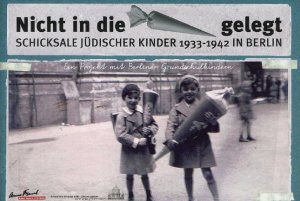 That old tradition that unites all school children led to the idea to launch a unique remembrance project, initiated by Carolyn Naumann and co-organized by the Anne-Frank-Zentrum and the Humboldt University in Berlin: “The sugar cone project” — a collection of photographs of German Jewish schoolchildren just before they fled Nazi Germany into exile and their stories of life before the war. The idea for the project was born while Naumann accompanied German Jewish refugees on their federally funded visit to their hometown, Berlin, where they shared such childhood memories as standing side-by-side with their non-Jewish school friends, all proudly displaying their cones. (In the picture, the brochure of the project, showing Heinz Goldstein on the left with an unknown friend, ca. 1935, in the Jewish Elementary School Fasanenstrasse in Berlin).
That old tradition that unites all school children led to the idea to launch a unique remembrance project, initiated by Carolyn Naumann and co-organized by the Anne-Frank-Zentrum and the Humboldt University in Berlin: “The sugar cone project” — a collection of photographs of German Jewish schoolchildren just before they fled Nazi Germany into exile and their stories of life before the war. The idea for the project was born while Naumann accompanied German Jewish refugees on their federally funded visit to their hometown, Berlin, where they shared such childhood memories as standing side-by-side with their non-Jewish school friends, all proudly displaying their cones. (In the picture, the brochure of the project, showing Heinz Goldstein on the left with an unknown friend, ca. 1935, in the Jewish Elementary School Fasanenstrasse in Berlin).
The collection of pictures showing six-years-olds and their sugar cones — just before they were deemed unfit to stay (or were sent to their death) — can help school children of today understand the realities of that time, the brutality of daily struggles, when people were clinging to even a sliver of normalcy.
If you have photos of that time, showing Jewish schoolchildren with their sugar cones, or would like to share your story, please contact Carolyn Naumann, who is also searching for teachers that are interested in the project and would like to help.

The Jewish Museum in Berlin is showing the exhibition “Zwangsarbeit” (Forced Labor: The Germans, the Forced Laborers, and the War). The exhibit is open until January 30, 2011.
In Germany during World War II, forced laborers were exploited on nearly every building site and farm, in every industrial enterprise, and even in private households. Over 20 million men, women, and children were taken to Germany and the occupied territories from all over Europe as “foreign workers,” prisoners of war, and concentration camp inmates to perform forced labor.
The exhibition “Forced Labor. The Germans, the Forced Laborers, and the War” provides the first comprehensive presentation of the history of forced labor and its ramifications after 1945. The historical exhibits and photographs explore the relationship – defined by racism – between Germans and forced laborers, offering insight into its many varying manifestations.

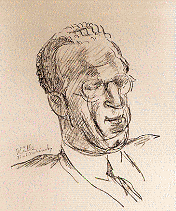 I am a German writer of biographies and am researching for years about Paul Huldschinsky (at left, a sketch drawn by Paul’s father, Oscar Huldschinsky].
I am a German writer of biographies and am researching for years about Paul Huldschinsky (at left, a sketch drawn by Paul’s father, Oscar Huldschinsky].
Paul Huldschinsky fled Germany in 1938 and emigrated to California. He was responsible for the interior decorations of Thomas Mann’s house in Pacific Palisades, and as Art Director, he received the Oscar for the film “Gaslight” with Ingrid Bergmann.
I am looking for photos or pictures in magazines or newspapers of him and his work.
—E-M Herbertz, emherbertz@aol.com

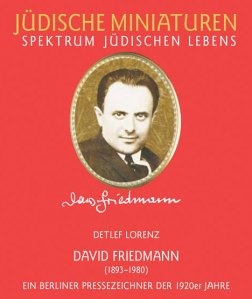 I am searching for the lost art of David Friedmann (1893-1980). He was a student of Hermann Struck (etching) and Lovis Corinth (painting). He achieved acclaim and a great reputation as a painter known for his portraits drawn from life. His talent for quick sketching gave rise to an additional career as a freelance artist in 1924-1933 for Berlin’s great newspapers and the radio program magazine, Der Deutsche Rundfunk. He was a leading Pressezeichner of the 1920’s and portrayed hundreds of celebrated personalities from the Arts, Music, Theater, Sports, and Politics.
I am searching for the lost art of David Friedmann (1893-1980). He was a student of Hermann Struck (etching) and Lovis Corinth (painting). He achieved acclaim and a great reputation as a painter known for his portraits drawn from life. His talent for quick sketching gave rise to an additional career as a freelance artist in 1924-1933 for Berlin’s great newspapers and the radio program magazine, Der Deutsche Rundfunk. He was a leading Pressezeichner of the 1920’s and portrayed hundreds of celebrated personalities from the Arts, Music, Theater, Sports, and Politics.
He fled to Prague with his family at the end of 1938, only to be deported to the Lodz Ghetto in October 1941. The Gestapo looted his oeuvre in 1941 in Berlin and again in Prague under the auspices of the Deutsches Reich. His works comprising of 2000 etchings, lithographs, drawings, and paintings are lost without a trace along with art that was sold or displaced as a consequence of war. Some art was saved by fleeing refugees from Hitler and scattered to unknown places throughout the world.
Although few prewar works have surfaced, an amazing treasure of 300 “published” portraits was discovered: Alexander Kipnis, Jan Kiepura, Else Eckersberg, Arnold Schönberg, Georg Széll, Wolfgang Stresemann, Gregor Piatigorsky, Szymon Goldberg, Richard Tauber, Therese Rothauser, Leo Slezak, Curt Bois, Carl Ebert, Emanuel Lasker, Richard Réti, and Ernst Toller, among others.
However, hundreds of portraits still remain elusive, including the twelve-year old Yehudi Menuhin performing at his first concert in Berlin. The drawing appeared on April 13, 1929, the day after his concert and may have been published in any number of newspapers throughout Germany. Other “known” lost portraits are: Albert Einstein, Rabindranath Tagore, Ramsey MacDonald, Edouard Herriot, Thomas Mann, Martin Buber, Max Brod, Carl Flesch, Raya Garbusova, Bronislaw Huberman, Jan Kubelik, Edwin Fischer, Rachelle Shubow, Eduard Rothauser, Benjamino Gigli, Mattia Battistini, Max Schmeling, and Ernst Udet.
The portraits were autographed by the subject and signed by the artist in a variety of styles and signatures: D. Friedmann, Dav. Friedmann, DaFrie, Fried, DF, Fr.Dav, or just Friedmann.
I would be grateful for leads to artwork by David Friedmann. My aim is to create a catalogue of his works, evidence of his brilliant career the Nazis could not destroy. Thus, I appeal to the public to join my search and preserve the legacy of this remarkable artist.
For more info:
David Friedmann (1893-1980) Ein Berliner Pressezeichner der 1920er Jahre By Detlef Lorenz; ISBN 978-3-938485-77-4
David Friedmann, A Berlin Press Artist of the 1920’s
Searching for the Lost Art of David Friedmann
Portfolio of Portraits of Famous Chess Masters
Berühmte Musiker – gezeichnet von David Friedmann
— Miriam Friedman Morris, mirifm@aol.com

 My father did 2 years hard labor in Christianstadt/Germany (Krzystkowice/Poland) for die Dynamit Aktiengesellschaft during World War II.
My father did 2 years hard labor in Christianstadt/Germany (Krzystkowice/Poland) for die Dynamit Aktiengesellschaft during World War II.
I am looking for anybody who had a relative or knows somebody else, who did hard labor there as well for die Dynamit Aktiengesellschaft during the War. Please contact Harm Karst Johannes Breman, Zwolle, Holland
[I suggest reading Hildegard Taussig Friedman‘smemoirs (1941-1945) “Meine Lebensgeschichte” (in German). Taussig Friedman was sent to Christianstadt, among other camps. To research further, I also recommend visiting the United States Holocaust Memorial Museum’s website regarding its 2002 symposium “Forced and Slave Labor in Nazi-Dominated Germany” with downloadable podcasts. The Museum has also records of the transport list from Gross-Rosen/Kommando Christianstadt to Parschnitz, Nov. 24, 1944 and Dec. 2, 1945. — Tekla Szymanski]
German Books Return to Germany
July 15, 2011Posted in Comment | Leave a Comment »